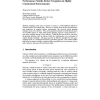Free Online Productivity Tools
i2Speak
i2Symbol
i2OCR
iTex2Img
iWeb2Print
iWeb2Shot
i2Type
iPdf2Split
iPdf2Merge
i2Bopomofo
i2Arabic
i2Style
i2Image
i2PDF
iLatex2Rtf
Sci2ools
FSR
2007
Springer
2007
Springer
State Space Sampling of Feasible Motions for High Performance Mobile Robot Navigation in Highly Constrained Environments
Sampling in the space of controls or actions is a well-established method for ensuring feasible local motion plans. However, as mobile robots advance in performance and competence in complex outdoor environments, this classical motion planning technique ceases to be effective. When environmental constraints severely limit the space of acceptable motions or when global motion planning expresses strong preferences, a state space sampling strategy is more effective. While this has been clear for some time, the practical question is how to achieve it while also satisfying the severe constraints of vehicle dynamic feasibility. This paper presents an effective algorithm for state space sampling based on a model-based trajectory generation approach. This method enables high-speed navigation in highly constrained and/or partially known environments such as trails, roadways, and dense off-road obstacle fields.
| Added | 07 Jun 2010 |
| Updated | 07 Jun 2010 |
| Type | Conference |
| Year | 2007 |
| Where | FSR |
| Authors | Thomas M. Howard, Colin J. Green, Alonzo Kelly |
Comments (0)

